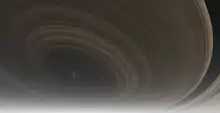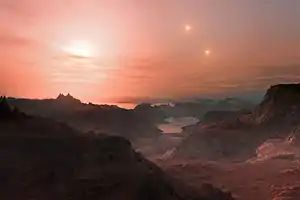2010 WG9
2010 WG9 is a high inclination trans-Neptunian object and slow rotator from the outer Solar System, approximately 100 kilometers in diameter.[1] It was first observed at ESO's La Silla Observatory in northern Chile on 30 November 2010.[2]
| Discovery [1] | |
|---|---|
| Discovered by | LaSilla–Quest Variability Srvy. |
| Discovery site | La Silla Observatory |
| Discovery date | 30 November 2010 (discovery: first observation only) |
| Designations | |
| 2010 WG9 | |
| TNO [1] · centaur · distant [2] | |
| Orbital characteristics [1] | |
| Epoch 4 September 2017 (JD 2458000.5) | |
| Uncertainty parameter 3 | |
| Observation arc | 6.22 yr (2,271 days) |
| Aphelion | 87.037 AU |
| Perihelion | 18.765 AU |
| 52.901 AU | |
| Eccentricity | 0.6453 |
| 384.77 yr (140,538 days) | |
| 10.821° | |
| 0° 0m 9.36s / day | |
| Inclination | 70.331° |
| 92.065° | |
| 293.00° | |
| Physical characteristics | |
| Dimensions | 100.81 km (calculated)[3] 112.7±61.9 km[4] |
| 263.8±0.1 h[5] | |
| 0.074±0.080[4] 0.10 (assumed)[3] | |
| B–R = 1.10[6] B–V = 0.798±0.034[5] V–R = 0.520±0.018[5] | |
| 8.1[1][3] | |
Orbit and classification
2010 WG9 orbits the Sun at a distance of 18.8–87.0 AU once every 384 years and 9 months (140,538 days). Its orbit has an eccentricity of 0.65 and an inclination of 70° with respect to the ecliptic.[1]
As of October 2019, it is one of six known objects with inclination (i) > 60° and perihelion (q) > 15 AU, along with the first discovered 2008 KV42.[7]
Physical characteristics
Rotation period
A rotational lightcurve of 2010 WG9 was obtained from photometric observations by the LaSilla–Quest Variability Survey at La Silla in Chile. Lightcurve analysis gave a rotation period of 263.8 hours with a brightness amplitude of 0.14 magnitude (U=2).[5] It belongs to the Top 200 slowest rotators known to exist.
Diameter and albedo
It measures 112.7 kilometers in diameter and its surface has an albedo of 0.074.[4] The Collaborative Asteroid Lightcurve Link assumes a standard albedo of 0.10 and calculates a diameter of 100.81 kilometers based on an absolute magnitude of 8.1.[3]
References
- "JPL Small-Body Database Browser: (2010 WG9)" (2016-03-13 last obs.). Jet Propulsion Laboratory. Retrieved 25 July 2017.
- "2010 WG9". Minor Planet Center. Retrieved 25 July 2017.
- "LCDB Data for (2010)". Asteroid Lightcurve Database (LCDB). Retrieved 25 July 2017.
- Bauer, James M.; Grav, Tommy; Blauvelt, Erin; Mainzer, A. K.; Masiero, Joseph R.; Stevenson, Rachel; et al. (August 2013). "Centaurs and Scattered Disk Objects in the Thermal Infrared: Analysis of WISE/NEOWISE Observations". The Astrophysical Journal. 773 (1): 11. arXiv:1306.1862. Bibcode:2013ApJ...773...22B. doi:10.1088/0004-637X/773/1/22. S2CID 51139703.
- Rabinowitz, David; Schwamb, Megan E.; Hadjiyska, Elena; Tourtellotte, Suzanne; Rojo, Patricio (July 2013). "The Peculiar Photometric Properties of 2010 WG9: A Slowly Rotating Trans-Neptunian Object from the Oort Cloud". The Astronomical Journal. 146 (1): 10. arXiv:1305.5134. Bibcode:2013AJ....146...17R. doi:10.1088/0004-6256/146/1/17. S2CID 119206739.
- "List of Known Trans-Neptunian Objects". Johnston's Archive. Retrieved 26 July 2017.
- "Custom query: i = 60 and q = 15+". Minor Planet Center. Retrieved 26 July 2017.
External links
- List Of Centaurs and Scattered-Disk Objects, Minor Planet Center
- 2010 WG9 at AstDyS-2, Asteroids—Dynamic Site
- 2010 WG9 at the JPL Small-Body Database


